Abstract
A 3-year longitudinal survey in a residential institution for the mentally retarded was carried out to study the epidemiology of hepatitis B virus (HBV) and to elucidate the different responses which Down's syndrome (DS) and non-Down's (ND) subjects have to HBV infection. Sensitive tests for the HBV surface antigen and antibody (HBsAg and anti-HBs), core antibody (anti-HBc) and `e' antigen and antibody (HBeAg and anti-HBe) were used. The HBsAg and anti-HBs content of positive sera was quantitated accurately.
All twenty-six chronic carriers of HBsAg possessed anti-HBc and 73% possessed HBeAg. The presence of HBeAg was correlated with abnormal liver function and high titres of HBsAg. The fifty-nine DS inmates possessing anti-HBs at the beginning of the study had significantly lower anti-HBs titres than the corresponding forty-nine ND subjects, but had a higher frequency of both anti-HBc and anti-HBe. Within both DS and ND groups the presence of anti-HBe was correlated with higher anti-HBs titres and within the ND group, high anti-HBs titres were also correlated with the presence of anti-HBc. Most inmates possessing HBV markers at the beginning of the study retained them for its duration.
Of the initially seronegative inmates, proportionately more DS (88%) than ND (54%) acquired HBV markers during the study; of these converters, proportionately more DS than ND (33% vs 10%) infections had chronic HBsAg carriage as the outcome. Most of these chronic HBsAg cases also acquired persistent HBeAg. In those seronegatives converting to anti-HBs, anti-HBc and anti-HBe tended to be more frequent in DS than ND groups, and patients with anti-HBe possessed higher anti-HBs titres than those without anti-HBe. These findings were similar to those seen in those inmates positive for anti-HBs at the beginning of the study (the anti-HBs group). However, unlike the anti-HBs group, the peak anti-HBs titres achieved after primary HBV infection (seroconversion) tended to be higher in the DS than in the ND group. The latter results are interpreted as indicating that a deficient humoral response in DS inmates is unlikely to be responsible for the high rates of chronic HBsAg carriage so often seen in these subjects.
Full text
PDF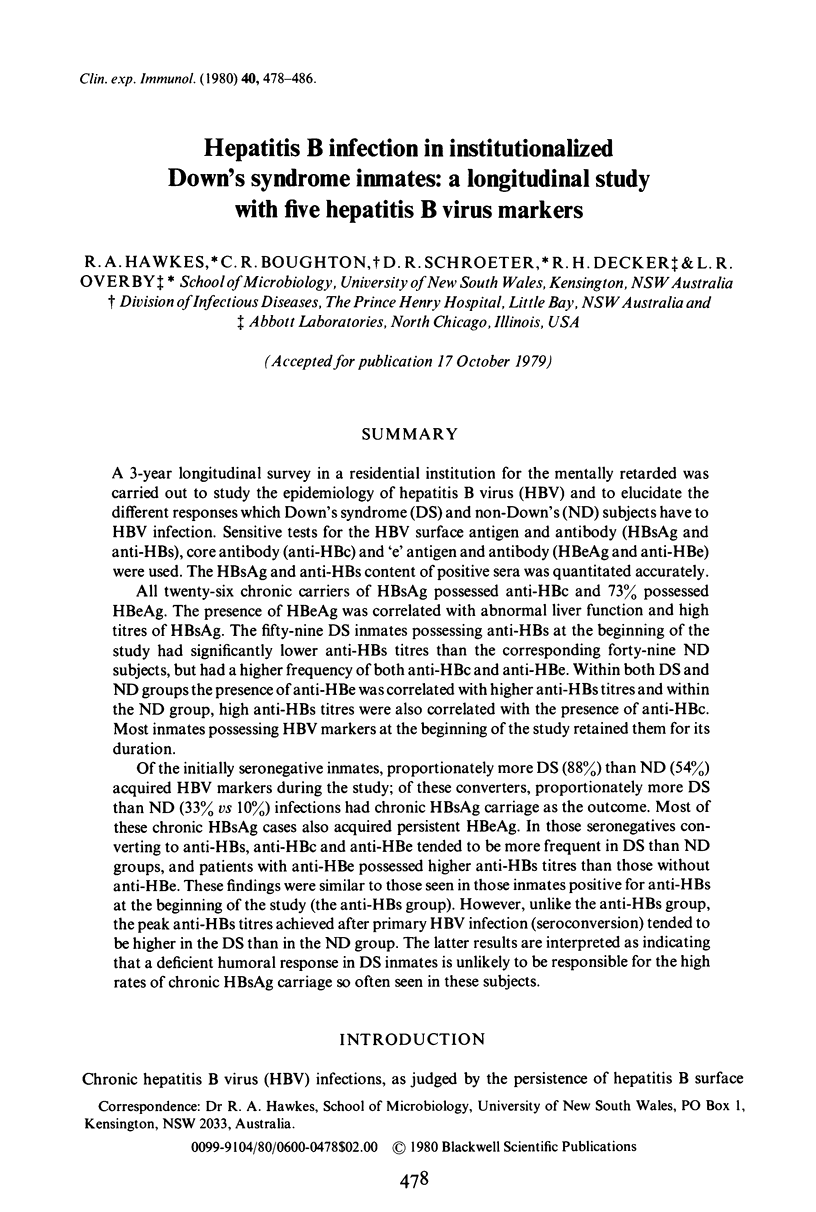
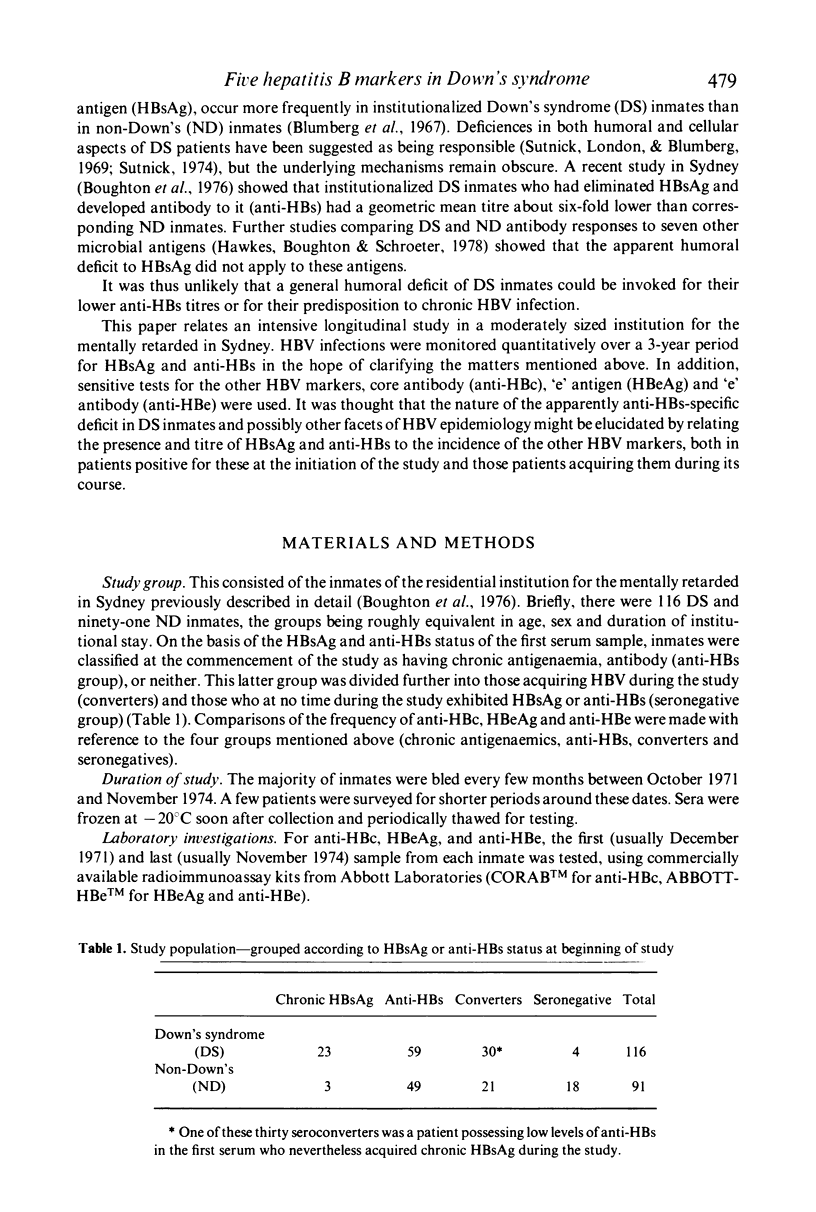


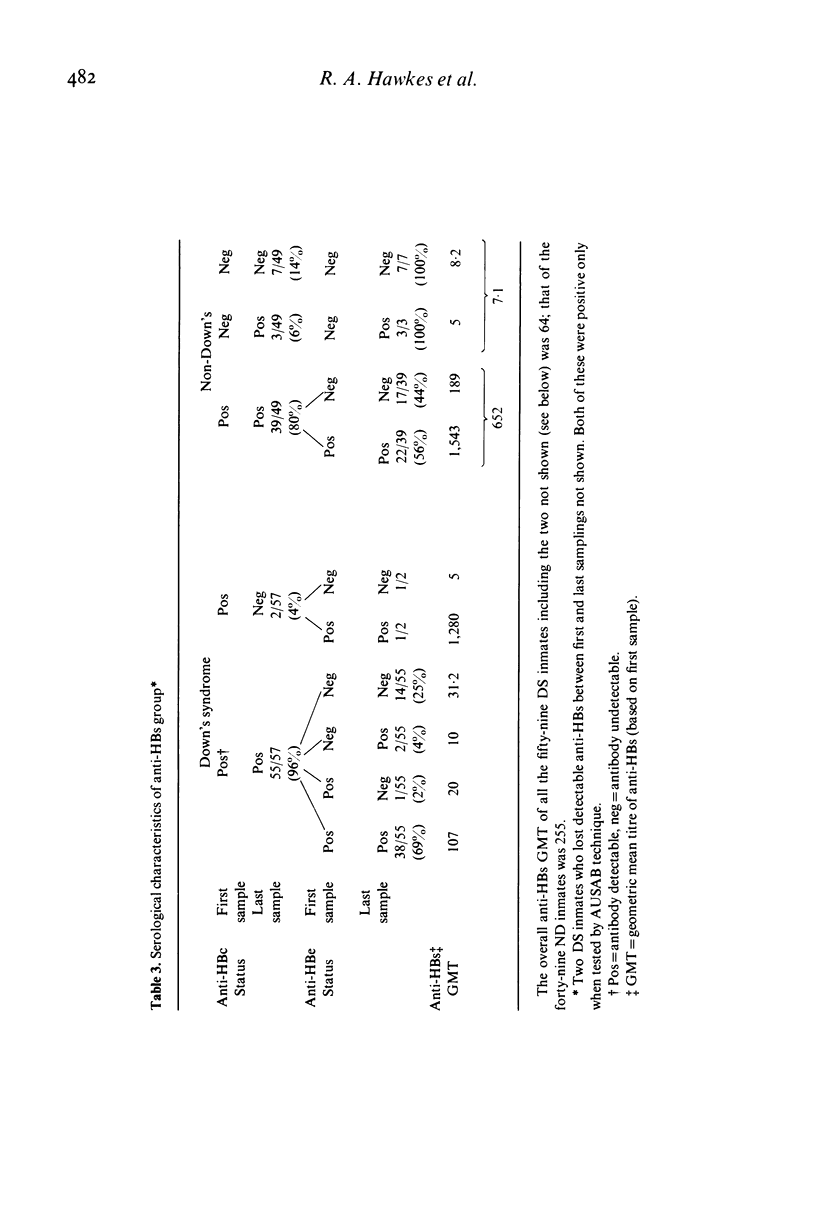
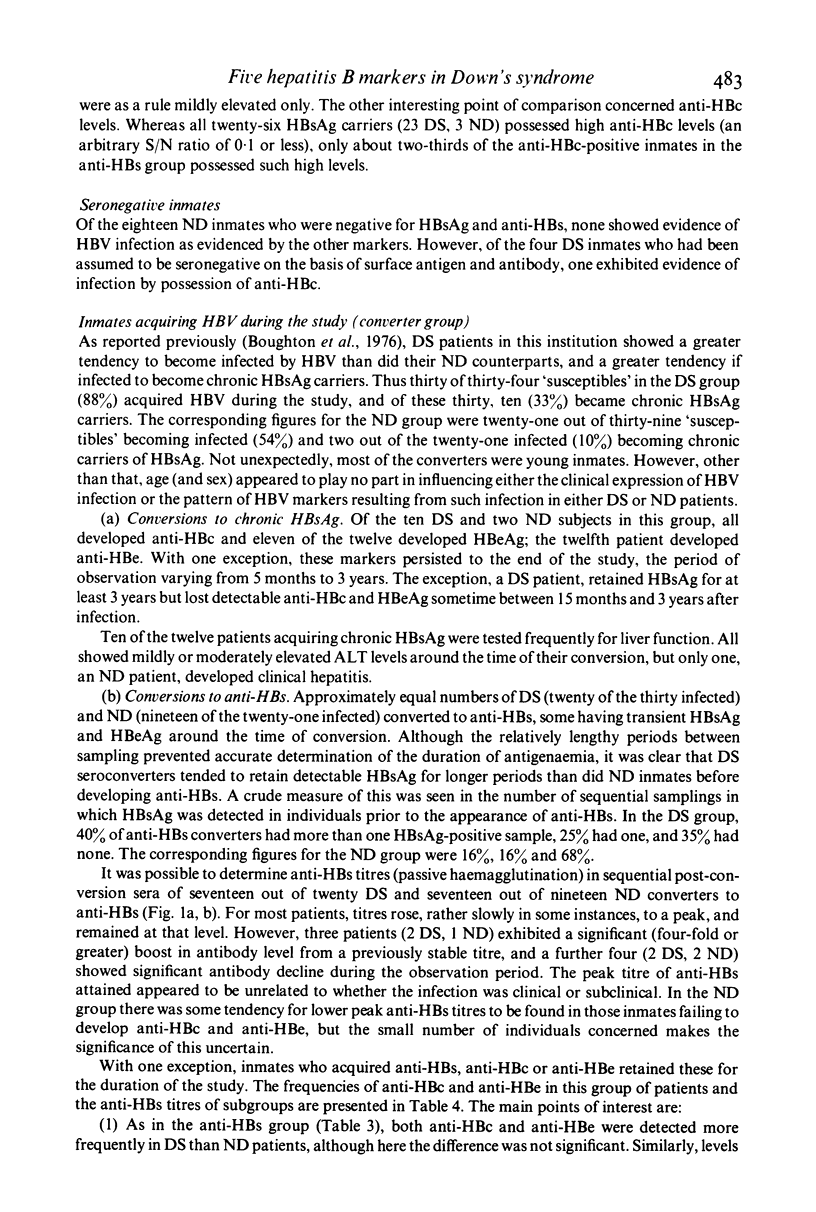
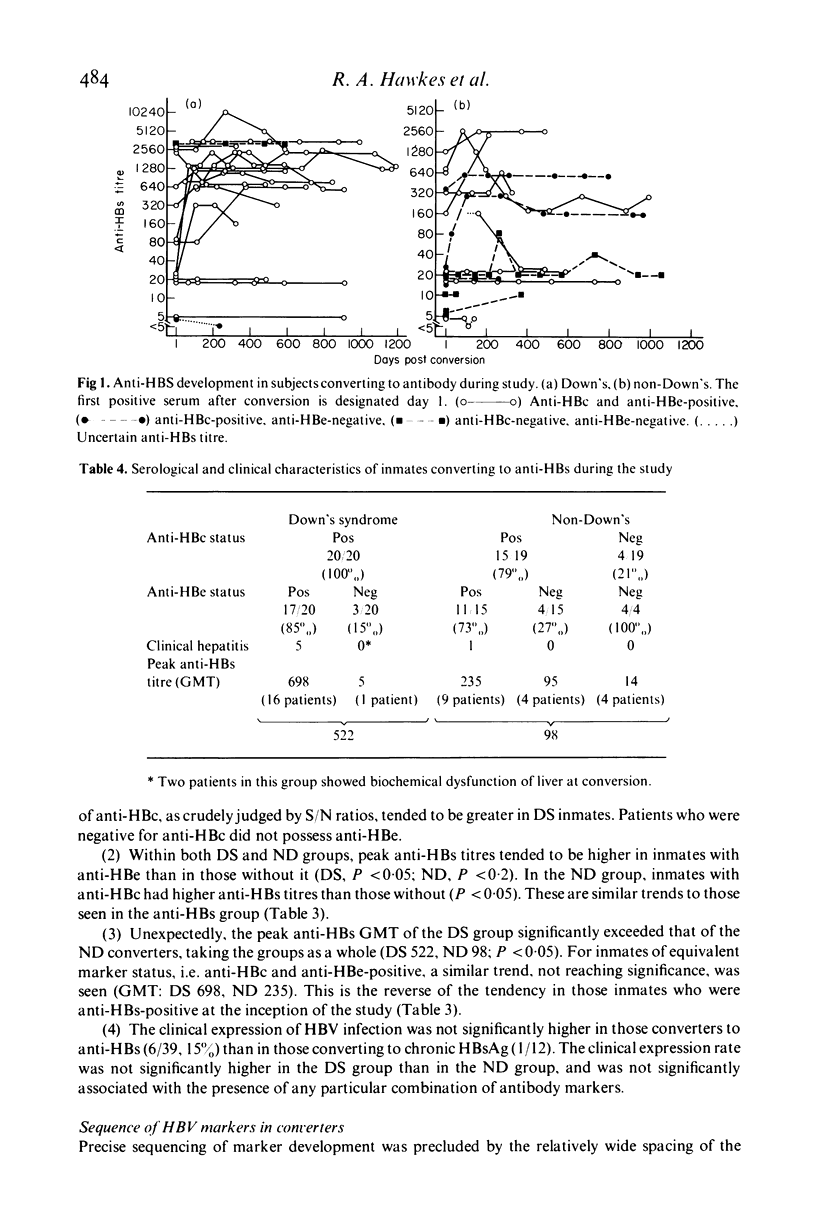
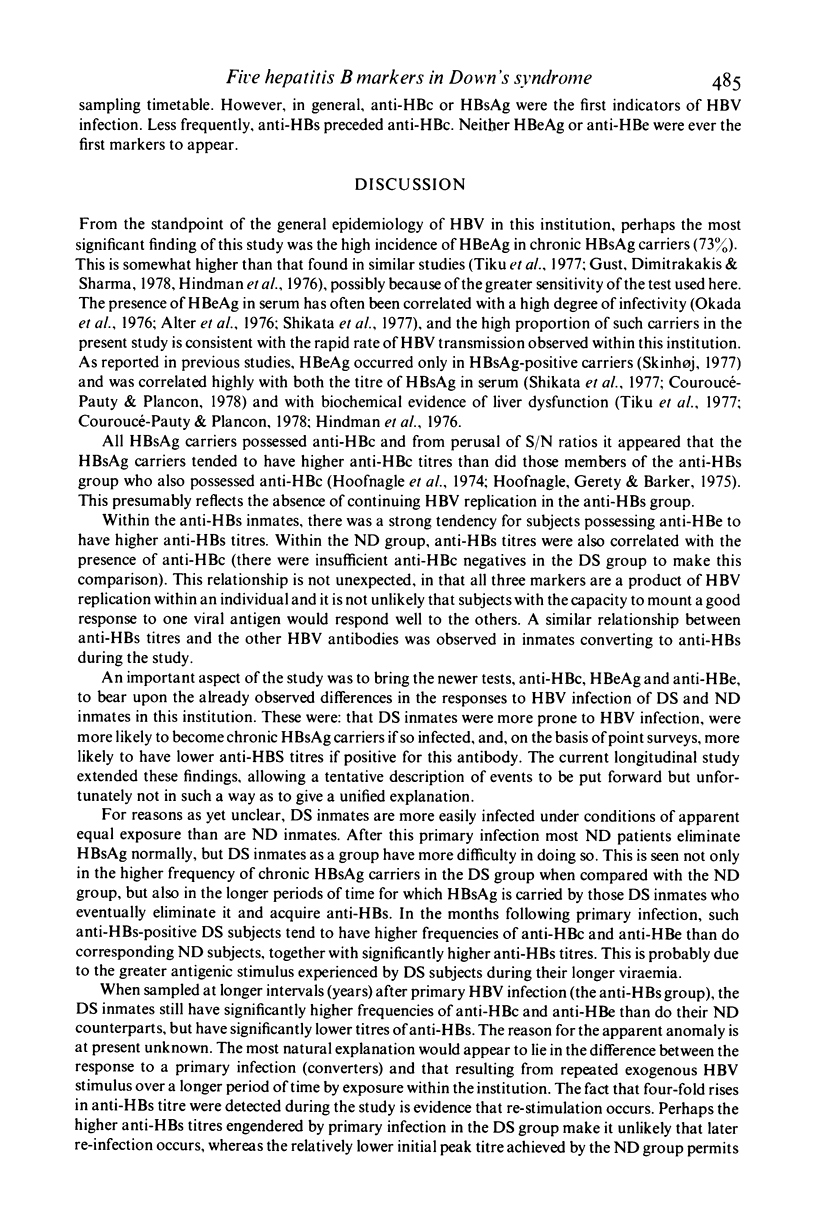

Selected References
These references are in PubMed. This may not be the complete list of references from this article.
- Alter H. J., Seeff L. B., Kaplan P. M., McAuliffe V. J., Wright E. C., Gerin J. L., Purcell R. H., Holland P. V., Zimmerman H. J. Type B hepatitis: the infectivity of blood positive for e antigen and DNA polymerase after accidental needlestick exposure. N Engl J Med. 1976 Oct 21;295(17):909–913. doi: 10.1056/NEJM197610212951701. [DOI] [PubMed] [Google Scholar]
- Blumberg B. S., Gerstley B. J., Hungerford D. A., London W. T., Sutnick A. I. A serum antigen (Australia antigen) in Down's syndrome, leukemia, and hepatitis. Ann Intern Med. 1967 May;66(5):924–931. doi: 10.7326/0003-4819-66-5-924. [DOI] [PubMed] [Google Scholar]
- Boughton C. R., Hawkes R. A., Schroeter D. R., Harlor J. A. The epidemiology of hepatitis B in a residential institution for the mentally retarded. Aust N Z J Med. 1976 Dec;6(6):521–529. doi: 10.1111/j.1445-5994.1976.tb03985.x. [DOI] [PubMed] [Google Scholar]
- Couroucé-Pauty A. M., Plançon A. e-Antigen and anti-e in two categories of chronic carriers of hepatitis B surface antigen. Vox Sang. 1978;34(4):231–238. doi: 10.1111/j.1423-0410.1978.tb02473.x. [DOI] [PubMed] [Google Scholar]
- Gust I. D., Dimitrakakis M., Sharma D. L. The prevalence of HBeAg and anti-HBe in an institution for the mentally retarded. Aust N Z J Med. 1978 Oct;8(5):471–473. doi: 10.1111/j.1445-5994.1978.tb02584.x. [DOI] [PubMed] [Google Scholar]
- Hawkes R. A., Boughton C. R., Schroeter D. R. The antibody response of institutionalized Down's syndrome patients to seven microbial antigens. Clin Exp Immunol. 1978 Feb;31(2):298–304. [PMC free article] [PubMed] [Google Scholar]
- Hindman S. H., Gravelle C. R., Murphy B. L., Bradley D. W., Budge W. R., Maynard J. E. "e" Antigen, Dane particles, and serum DNA polymerase activity in HBsAg carriers. Ann Intern Med. 1976 Oct;85(4):458–460. doi: 10.7326/0003-4819-85-4-458. [DOI] [PubMed] [Google Scholar]
- Hoffnagle J. H., Gerety R. J., Barker L. F. Antibody to hepatitis B core antigen. Am J Med Sci. 1975 Jul-Aug;270(1):179–187. doi: 10.1097/00000441-197507000-00025. [DOI] [PubMed] [Google Scholar]
- Hoofnagle J. H., Gerety R. J., Ni L. Y., Barker L. F. Antibody to hepatitis B core antigen. A sensitive indicator of hepatitis B virus replication. N Engl J Med. 1974 Jun 13;290(24):1336–1340. doi: 10.1056/NEJM197406132902402. [DOI] [PubMed] [Google Scholar]
- Okada K., Kamiyama I., Inomata M., Imai M., Miyakawa Y. e antigen and anti-e in the serum of asymptomatic carrier mothers as indicators of positive and negative transmission of hepatitis B virus to their infants. N Engl J Med. 1976 Apr 1;294(14):746–749. doi: 10.1056/NEJM197604012941402. [DOI] [PubMed] [Google Scholar]
- Shikata T., Karasawa T., Abe K., Uzawa T., Suzuki H., Oda T., Imai M., Mayumi M., Moritsugu Y. Hepatitis B e antigen and infectivity of hepatitis B virus. J Infect Dis. 1977 Oct;136(4):571–576. doi: 10.1093/infdis/136.4.571. [DOI] [PubMed] [Google Scholar]
- Skinhoj P. Hepatitis and hepatitis B-antigen in Greenland. II: Occurrence and interrelation of hepatitis B associated surface, core, and "e" antigen-antibody systems in a highly endemic area. Am J Epidemiol. 1977 Feb;105(2):99–106. doi: 10.1093/oxfordjournals.aje.a112371. [DOI] [PubMed] [Google Scholar]
- Sutnick A. I. Australia antigen and the immune response in human diseases. J Allergy Clin Immunol. 1974 Jan;53(1):42–51. doi: 10.1016/0091-6749(74)90098-0. [DOI] [PubMed] [Google Scholar]
- Sutnick A. I., London W. T., Blumberg B. S. Effects of host and environment on immunoglobulins in Down's syndrome. Arch Intern Med. 1969 Dec;124(6):722–725. [PubMed] [Google Scholar]
- Tiku M. L., Makhdoomi G. M., Beutner K. R., Nath N., Ogra P. L. Hepatitis B e antigen and antibody activity in hepatitis B virus infection. J Pediatr. 1977 Oct;91(4):540–544. doi: 10.1016/s0022-3476(77)80498-8. [DOI] [PubMed] [Google Scholar]
- Vyas G. N., Shulman N. R. Hemagglutination assay for antigen and antibody associated with viral hepatitis. Science. 1970 Oct 16;170(3955):332–333. doi: 10.1126/science.170.3955.332. [DOI] [PubMed] [Google Scholar]


